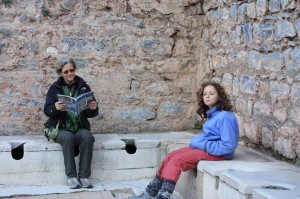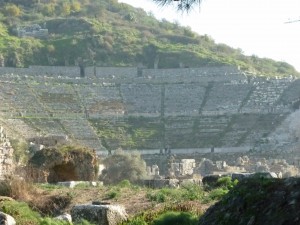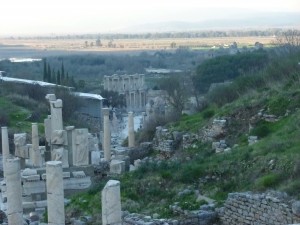Yes, this is the same Ephesus that Paul preached at, and home to the church to which he wrote the book of Ephesians. It is also reported to be where Mary, the mother of Jesus, lived with the apostle John at the end of her life, and where it is thought they both were buried. Still, for our purposes, the more important thing was that this is the Ephesus where stood one of the Seven Wonders of the Ancient World; the Temple of Artemis. Sadly, the only thing that remains of the temple is one standing column. It was damaged by multiple earthquakes, nearly done in by the ransacking of the Goths in 268, and finally was completely demolished on the orders of the area’s Christian archbishop in 401. It had a rough life; reportedly having been rebuilt seven times. However, at the end, the decreased importance of the city, and the Christianization of the Roman Empire, with its consequent diminished use as a temple, doomed it. Sadly, the materials were carted away to be used in the building of many other buildings, including the Hagia Sofia in what was then Constantinople, the church of St John in Ephesus, some city walls, and a mosque in the city.
I am getting ahead of myself, though. We arrived in Selcuk, the current name of the city of Ephesus with great expectations. We had heard from others that it was one of the highlights of Turkey, and we were not disappointed. The city’s location has been in the same area for thousands of years, though it has shifted slightly over the ages due to the silting in of the river delta. Currently, the city is about four miles from the ocean. Hard to imagine just two thousand years ago that the city had an ocean harbor. Under the Greeks, and especially with the takeover by the Romans, it grew to be one of the most important cities in the world and the second largest. The famous Temple of Artemis was finished in about 550 BC, and was huge, truly a wonder. At about 450 ft by 225 ft and with a height of about 60 ft, it was the largest building in the world. However, there was much more to the city than just the temple. The ruins of the city have been extensively renovated to give an idea of what it must have been like. We walked the nearly 1.5 mile marble paved street from end to end. All types of beautiful buildings were there; temples, fountains, theaters, markets, homes, and even public toilets, an advance that many current cities we have visited still do not have.
Some grand, some merely functional, they were all impressive, particularly the amphitheater that sat around 44,000.
It really helped one understand why the Greeks looked at non-Greeks as barbarians. While the rest of Europe built wood or straw structures, none of which were of any significant size, the Greeks built massive marble structures of beauty that are no less admired today, wrote plays and stories that attracted thousands to their performances, schooled their children, revered their thinkers, and established the idea of the rule of law and government by the people. Walking through the ruins, I found myself admiring the open spaces, and the beauty of the buildings. True, for the masses, life would still have been hard, but they had access to the things of beauty and culture. I could have happily lived there during those times. But sadly, all good things must come to an end. After the fall of Roman Empire, and with the loss of its harbor, it rapidly declined, and by the year 1000, it was back to being a small village. One distinction does remain, though. As it was 2,000 years ago, it is a great tourist attraction.



Your hair is getting so long Emma!
Grace